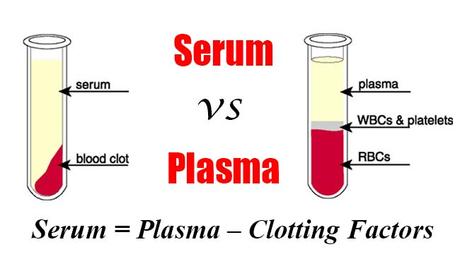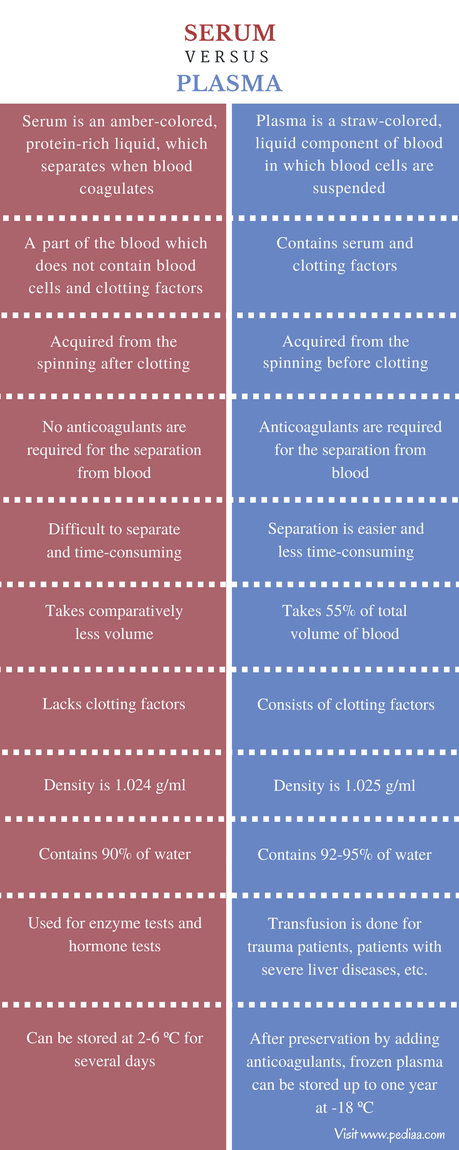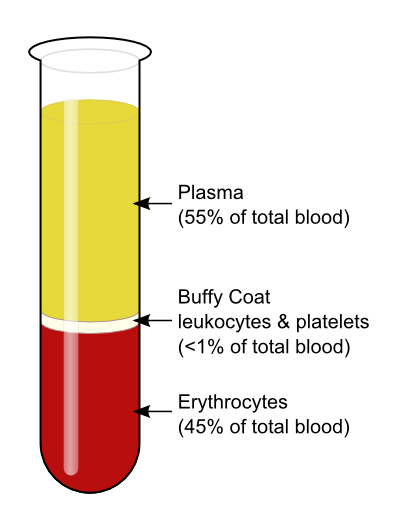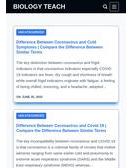 Source link
Source link
The main difference between plasma and serum is that serum is the protein-rich liquid, which separates when blood coagulates whereas plasma is the liquid component of blood which holds blood cells in whole blood in suspension.
Plasma is that part of the blood, which contains a blood-clotting agent called fibrinogen, while serum is the fluid part of the blood and does not contain a clotting agent. The plasma and serum can be extracted from the centrifugation of blood. The serum is obtained after the clotting of blood, while plasma can be obtained before the coagulation of the blood. Centrifugation separates the blood components by its weight, size, and density.
The fluid circulating in the body through arteries and veins is called blood. It is an important part of the body’s immune system which supplies oxygen to the tissue and takes the carbon dioxide to get excreted.
Another important role of blood is to provide nutrients, hormones, electrolytes to the cell. Blood is composed of white blood cells, red blood cells, and platelets, floating in the liquid called the plasma. It is said that blood makes up 8% of the total body weight.
So blood plays the role of connective tissue having the liquid matrix, carrying the cells, and another liquid part. In the provided article we will discuss the difference between plasma and serum, and their functions.
Top 17 Differences Between Serum and Plasma & Similarities
S.N. BASIS FOR COMPARISON Serum Plasma
1. Definition The serum is the liquid part of the blood after the coagulation. Plasma is a clear and yellowish fluid part of the blood.
2. Composition The serum is the water fluid from blood without the clotting factors. Plasma is the blood fluid that contains blood-clotting agents.
3. Volume The volume of serum is less in comparison to plasma. Plasma is a clear yellow liquid which is 55% of the total volume of blood.
4. Isolation The serum is acquired from the process of spinning after clotting. Plasma is acquired from the process of spinning before clotting.
5. Isolation Procedure The serum is more difficult and time consuming to separate. Plasma is easier and less time consuming to separate as compared with serum.
6. Use of Anticoagulants The serum does not need anticoagulants for separation. Anticoagulants are necessary to separate plasma.
7. Composition The serum contains proteins, electrolytes, antibodies, antigens, and hormones. Plasma is considered as the medium of blood in which RBCs (Red Blood Cells), WBC (White Blood Cells), and other components of blood are suspended.
8. Composition (Antibodies) The serum contains antibodies and cross-react with recipient antigen. Blood plasma contains antibodies, a type of protein that can fight a substance considered foreign to the host body.
9. Composition The serum contains proteins like albumin and globulins. Plasma contains clotting factors and water.
10. Fibrinogen Absent Present
11. Composition (Water) The serum contains 90% water. Plasma contains 92-95% of water.
12. Storage The serum can be stored at 2-6 degrees centigrade for several days. Frozen plasma can be stored for up to a year.
13. Density The serum has a density of approximately 1.024 g/ml. Plasma has a density of approximately 1025 kg/m3 or 1.025 g/ml.
14. Arrangement Cells are usually attached by clot formation. Cells are not attached and suspended in plasma.
15. Uses The serum is the most preferred part of blood used in checking blood groups. Plasma is delivered to the patients who lack blood cells.
16. Uses The serum is an important source of electrolytes and animal sera are used as anti-venom, anti-toxins, and vaccinations. Plasma contains proteins that help in the transportation of material such as glucose and other dissolved nutrients through the blood.
17. Uses The serum is used for various diagnostic tests used for determining the levels of hCG, cholesterol, proteins, sugar, etc., in the blood. Plasma aids in the maintenance of blood pressure and the regulation of body temperature
 Difference Between Serum and Plasma – Comparison Summary
Difference Between Serum and Plasma – Comparison Summary
Difference Between Serum and Plasma
Definition
Serum: Serum is an amber-colored, protein-rich liquid, which separates when blood coagulates.
Plasma: Plasma is a straw-colored, liquid component of blood in which blood cells are suspended.
Correspondence
Serum: Serum is the part of the blood which does not contain blood cells and clotting factors.
Plasma: Plasma contains serum and clotting factors.
Acquired From
Serum: Serum is acquired from the spinning after clotting.
Plasma: Plasma is acquired from the spinning before clotting.
Separation
Serum: No anticoagulants are required for the separation of serum from blood.
Plasma: Anticoagulants are required for the separation of plasma from the blood.
Separation Process
Serum: Serum is difficult to separate and time-consuming.
Plasma: The separation of plasma is comparatively easier and less time-consuming compared to serum.
Volume
Serum: The volume of serum is less than that of plasma.
Plasma: Plasma takes 55% of the total volume of blood.
Clotting Factors
Serum: Serum lacks clotting factors.
Plasma: Plasma consists of clotting factors.
Density
Serum: The density of the serum is 1.024 g/ml.
Plasma: The density of plasma is 1.025 g/ml.
Water
Serum: Serum contains 90% of water.
Plasma: Plasma contains 92-95% of water.
Medical Use
Serum: Serum is used for enzyme tests and hormone tests.
Plasma: Plasma transfusion is done for trauma patients, patients with severe liver diseases, etc.
Storage
Serum: Serum can be stored at 2-6 ºC for several days.
Plasma: After preservation by adding anticoagulants, frozen plasma can be stored up to one year at -18 ºC.
What are the Similarities Between Plasma and Serum?
- Both plasma and serum are present in the blood.
- They are vital components of the blood.
- Both contain metabolites, electrolytes, proteins, and antibodies.
- The process of centrifugation can isolate both these from the blood.
- Both are fluids.
- They have more than 90% of water.
Component The serum is a component of blood and the circulatory system. Plasma is a component of blood and the circulatory system .
Constituents Serum contains metabolites, electrolytes, proteins and antibodies. Plasma also contains metabolites, electrolytes, proteins and antibodies.
Isolation The serum is isolated by the process of centrifugation. Plasma is also isolated by the process of centrifugation .
Appearance The serum is a fluid left after the coagulation process. Plasma is also a fluid that can be extracted,
Definition of Plasma
Plasma is the liquid part of the blood where the components like hormones, cells, and nutrients float. More than half of the volume of the total blood is covered by plasma. It contains fibrinogen which is a clotting agent and helps in preventing the excessive flow of blood in case of injury.
The composition of the plasma includes albumin, globulin, hormones, gases, nitrogenous waste, nutrients, and amino acids. When the blood sample is spun in a centrifuge, the upper layer which is obtained in the blood sample is called the plasma.
 Figure 2: Scheme of a blood sample after centrifugation
Figure 2: Scheme of a blood sample after centrifugation
Functions: Plasma also contains proteins that are helpful in the transportation of materials through the blood to various parts of the body such as glucose and other nutrients. Plasma helps in the regulation of body temperature and in controlling the blood pressure.
The blood also used in the transfusion, especially in the case of hemophilia or other blood clotting disorders, burns, immunodeficiency. Plasma is separated from the blood, to increase the longevity up to years and can be easily carried from one place to another.
To understand directly- let’s experiment – By taking a small amount of blood sample in a test tube, and we allow to centrifuge it for some time, but before going for the centrifugation, add an anti-coagulating agent like heparin or EDTA.
The components will be separated based on their weight and density and will get divided into three parts, the lowermost part is known as RBC or red blood cells, which occupy 45% of the total sample. About 1% layer above that is WBC or white blood cells and platelets, which is present just above the layer of RBC and the topmost layer consist of plasma, which is more than half of the volume of the total blood sample .i.e., around 55% and is of yellow color.
We are interested in plasma, that contains 90% of water, 8% of proteins (albumin, globulin, and fibrinogen-clotting factor) and 2% regulatory proteins, electrolytes, nutrients, hormones, gases.
The most important thing is that we added before the centrifugation was the anticoagulant like heparin and EDTA, which is used to avoid clotting to get plasma in the liquid state.
Definition of Serum
Apart from plasma, there is another constituent present in the blood called serum. It is the fluid part of the blood and does not contain the blood clotting factor or blood cells. It is the resources for proteins, antigens, antibodies (IgG, IgM, IgE, IgD, IgA), electrolytes, and hormones. It helps diagnose diseases such as cholesterol, sugar, blood pressure, etc., and also in blood typing.
 Figure 02: Serum
Figure 02: Serum
The serum is obtained from the same above experiment, described above for obtaining plasma, but if we do not add any anticoagulant and allowed the blood to clot, by keeping it for 30 mints after centrifugation. The upper layer which is obtained is serum, and the layer which got settled at the bottom is the clotted blood.
Most importantly all the components of the blood are the same as that of plasma-like the water, electrolytes, nutrients, vitamins, nutrients, hormones, gases but are devoid of the fibrinogen. This is the primary factor that distinguishes them.
Key Differences Between Plasma and Serum
-
The Plasma is the watery or liquid fluid portion of the blood, in which several blood cells are diluted and is obtained after the centrifugation by adding the anti-coagulating agents. The fluid or undiluted part of the blood, obtained after the complete coagulation of the blood, without adding an anticoagulating agent is called serum.
-
Fibrinogen is present in the plasma, and it is absent in serum.
-
The anticoagulant agent like EDTA, Heparin is needed while the centrifugation process to separate plasma from other blood components, but the serum doesn’t need to separate.
-
Plasma is obtained, through the process of spinning of blood, and it gets separates easily whereas serum is obtained, through the process of spinning of blood after clotting, though serum is more difficult to separate.
-
Composition of plasma is the yellow part of the liquid which is 55% of the total volume of blood, carrying serum and clotting factors, water, albumin, and globulin whereas serum contains the very less part of blood, though lacks the clotting factors, it also contains antibodies, antigens, hormones, electrolytes, water, proteins, and antibodies, to cross-react with the recipient antigen
-
The volume of the plasma is 55% of the total blood, and density is approximately 1.025 g/ml, or 1025 kg/m3, whereas serum is less in volume comparatively having a density of 1.024 g/ml.
-
Plasma supports the transportation of materials like glucose and other nutrients through the blood; It also helps regulation of body temperature and in the maintenance of blood pressure. Plasma is used mostly in problems relates to blood-clotting. The animal serum is used as antitoxins, anti-venom, and vaccinations. It is also used in diagnosing the cholesterol, proteins, sugar level, etc., present in the blood. The serum is also used in blood typing.
Conclusion – Plasma vs Serum
We can say that blood is one of the most important parts of the body and helps in the transportation of nutrients, hormones, gases, vitamins, etc. and thus connecting each section. The blood contains three important components like-plasma, white blood, and red blood cells. We discuss the fundamental difference between the plasma and serum and how can be they separated. We also consider their uses and importance.
Reference:
- ”Blood Serum.” Merriam-Webster. Merriam-Webster, n.d. Web. 27 May 2017. <https://www.merriam-webster.com/dictionary/blood%20serum>.
- ”Medical Definition of Serum.” MedicineNet. N.p., n.d. Web. 27 May 2017. <http://www.medicinenet.com/script/main/art.asp?articlekey=5470>.
- ”Plasma.” American Red Cross. N.p., n.d. Web. 27 May 2017. <http://www.redcrossblood.org/learn-about-blood/blood-components/plasma>.
- Hess, John R. “Conventional blood banking and blood component storage regulation: opportunities for improvement.” Blood Transfusion. Edizioni SIMTI — SIMTI Servizi Srl, June 2010. Web. 27 May 2017. <https://www.ncbi.nlm.nih.gov/pmc/articles/PMC2897192/>
- Difference Between Plasma and Serum Link. Link.
Image Courtesy:
- “Blood-centrifugation-scheme” By KnuteKnudsen at English Wikipedia (CC BY 3.0) via Commons Wikimedia
- Difference Between Serum and Plasma – Comparison Summary Available Here
- 2.” Blood vial” By Wheeler Cowperthwaite from Reno, USA, (CC BY-SA 2.0) via Commons Wikimedia

